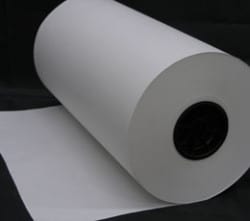Dye Sublimation: Paper used, direct printing, UV resistance, & environmental advantage.
Question: Do you use special paper for dye sublimation?
Yes. It’s called “dye sublimation transfer paper,” or just plain “dye sublimation paper.” Not terribly original, I know.
 The paper is treated to accept sublimation dye images in the CMYO (similar to CMYK, except the K, or black, is replaced with O, which stands for the overprint which creates black). This paper is matched up to a polymeric fabric (polyester), and run through a heat press which operates around 400 F.
The paper is treated to accept sublimation dye images in the CMYO (similar to CMYK, except the K, or black, is replaced with O, which stands for the overprint which creates black). This paper is matched up to a polymeric fabric (polyester), and run through a heat press which operates around 400 F.
As it passes through the pressurized and heated rollers, the dye changes to a gas, and because the polymers have been heated, the pores expand and open, and the gases fuse into the fabric or whatever is being sublimated, becoming part of the actual fiber of the fabric.
This gives the dye sublimation process that continuous tone look of a photograph which is also making this particular method and fabric increasingly popular, not only for display graphics, but also for clothing and other items that can be sublimate printed as well.
Question: Are you able to sublimate directly to the textile without using paper?
Sort of. You can print directly to fabric – it’s not dye sublimation though. It does have the advantage of being a one step process, but it is more costly for materials. It’s about a wash though, as there’s less labor. Personally, I think it’s pretty hard to tell the difference between a dye sub print and a direct to fabric print, although some people can. They have better eyes than I do, apparently.
Dye sublimation is a better process though when it comes to longevity of the print. Direct to fabric printing will not wear as well or wash as well or last as well in the sunlight (even in the interior of a building there are lots of stray UV rays).
Question: Does dye sublimation printing have UV resistance?
Yes. Indoors you can expect up to 30 years, and outdoors probably five years if it is a good brand of ink on an exterior grade polyester fabric.
No UV protection is added to the dyes to achieve this solid performance. The dyes are simply encapsulated into the polymers, and that produces some good UV resistance.
Question: Is there any environmental advantages to dye sublimation printing?
You might convince me to get on a soapbox on this question.
First, I will have to explain that I am a conservationist, and believe we should take care of our planet. Pick up litter. Don’t dump raw sewage into streams. Oil is bad for oceans. But things have gotten stupid with environmentalists who have taken conservationism and embued it with stupid politics so that these idiots like Al Gore can use environmentalism to make millions of dollars and zero sense.
So, to answer your question, the amount of residual waste from digital printing or dye sublimation printing is negligible, and if you make the ink out of soybeans, it won’t make squat worth of difference, regardless of some company that’s paying big bucks to get congress to pass a law that makes it so they will become stinking filthy rich based on baloney. Did that answer your question?
More about dye sublimation printing on large format fabric banners IN HERE.
Popular Posts:




